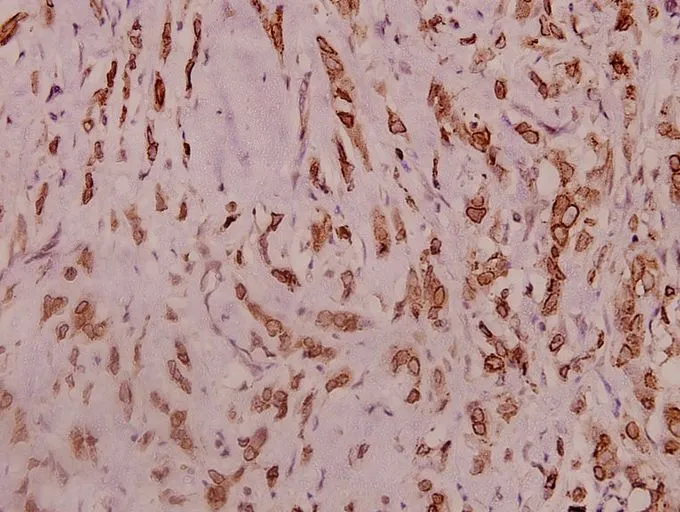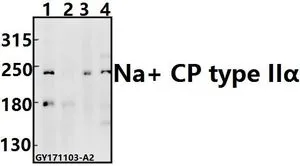
IHC-P analysis of human breast carcinoma tissue using GTX66721 Nav1.2 antibody. Dilution : 1:100
Nav1.2 antibody
GTX66721
ApplicationsWestern Blot, ImmunoHistoChemistry, ImmunoHistoChemistry Paraffin
Product group Antibodies
TargetSCN2A
Overview
- SupplierGeneTex
- Product NameNav1.2 antibody
- Delivery Days Customer9
- Application Supplier NoteWB: 1:500-1:1000. IHC-P: 1:50-1:200. *Optimal dilutions/concentrations should be determined by the researcher.Not tested in other applications.
- ApplicationsWestern Blot, ImmunoHistoChemistry, ImmunoHistoChemistry Paraffin
- CertificationResearch Use Only
- ClonalityPolyclonal
- Concentration1 mg/ml
- ConjugateUnconjugated
- Gene ID6326
- Target nameSCN2A
- Target descriptionsodium voltage-gated channel alpha subunit 2
- Target synonymsBFIC3, BFIS3, BFNIS, DEE11, EA9, EIEE11, HBA, HBSCI, HBSCII, NAC2, Na(v)1.2, Nav1.2, SCN2A1, SCN2A2, sodium channel protein type 2 subunit alpha, sodium channel protein brain II subunit alpha, sodium channel protein type II subunit alpha, sodium channel protein, brain type 2 alpha subunit, sodium channel, voltage-gated, type II, alpha 1 polypeptide, sodium channel, voltage-gated, type II, alpha 2 polypeptide, sodium channel, voltage-gated, type II, alpha subunit, voltage-gated sodium channel subtype II, voltage-gated sodium channel subunit alpha Nav1.2, voltage-gated sodium channel type II alpha subunit
- HostRabbit
- IsotypeIgG
- Protein IDQ99250
- Protein NameSodium channel protein type 2 subunit alpha
- Scientific DescriptionVoltage-gated sodium channels are transmembrane glycoprotein complexes composed of a large alpha subunit with four repeat domains, each of which is composed of six membrane-spanning segments, and one or more regulatory beta subunits. Voltage-gated sodium channels function in the generation and propagation of action potentials in neurons and muscle. This gene encodes one member of the sodium channel alpha subunit gene family. Allelic variants of this gene are associated with seizure disorders and autism spectrum disorder. Alternative splicing results in multiple transcript variants. [provided by RefSeq, Nov 2016]
- Storage Instruction-20°C or -80°C,2°C to 8°C
- UNSPSC12352203





